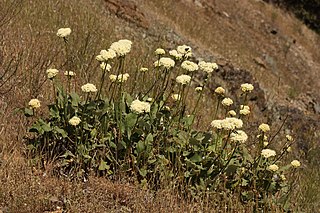
Eriogonum is a genus of flowering plants in the family Polygonaceae. The genus is found in North America and is known as wild buckwheat. This is a highly species-rich genus, and indications are that active speciation is continuing. It includes some common wildflowers such as the California buckwheat.
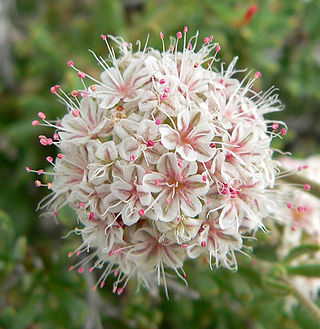
Eriogonum fasciculatum is a species of wild buckwheat known by the common names California buckwheat and flat-topped buckwheat. Characterized by small, white and pink flower clusters that give off a cottony effect, this species grows variably from a patchy mat to a wide shrub, with the flowers turning a rusty color after blooming. This plant is of great benefit across its various habitats, providing an important food resource for a diversity of insect and mammal species. It also provides numerous ecosystem services for humans, including erosion control, post-fire mitigation, increases in crop yields when planted in hedgerows, and high habitat restoration value.

Eriogonum parvifolium is a species in the family Polygonaceae that occurs on dune formations in the coastal area of Central and Southern California. This evergreen shrub grows to a height of 30 to 100 centimeters with a spread of approximately the same dimension. This plant is an important host for a number of pollinating insects including certain endangered species. E. parvifolium occurs both on bluffs along the Pacific Ocean coast as well as Coastal Strand dunes formations, but is restricted to altitudes below 700 meters. In at least one instance within the Carbonera Creek watershed, it occurs farther inland in a Maritime Coast Range Ponderosa Pine forest. This shrub is also known by the common names dune buckwheat, coast buckwheat, cliff buckwheat, or seacliff buckwheat.

Eriogonum alpinum is a species of wild buckwheat known by the common name Trinity buckwheat.

Eriogonum arborescens is a species of wild buckwheat known by the common name Santa Cruz Island buckwheat.

Eriogonum cinereum is a species of wild buckwheat known by the common names coastal buckwheat and ashyleaf buckwheat.
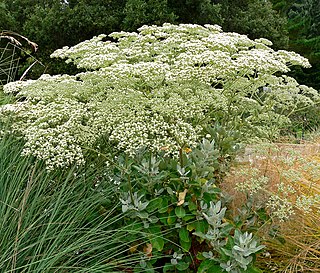
Eriogonum giganteum, with the common name St. Catherine's lace, is a species of wild buckwheat in Southern California.

Eriogonum incanum is a species of wild buckwheat known by the common name frosted buckwheat. It is native to the Sierra Nevada of California and extreme western Nevada. It is also known from Oregon.

Eriogonum nervulosum is a species of wild buckwheat known by the common name Snow Mountain buckwheat. This uncommon plant is endemic to the inland North Coast Ranges of California, where it is known from only a handful of occurrences, most of which are in Lake County. It is named for Snow Mountain, a local peak.

Eriogonum ovalifolium is a species of wild buckwheat known by the common name cushion buckwheat. It is native to western North America from California to Alberta, where it is a member of many plant communities in varied habitats, including the sagebrush steppe and alpine regions.

Eriogonum pyrolifolium is a species of wild buckwheat. It is native to western North America, from British Columbia to the high mountains of California.

Eriogonum umbellatum is a species of wild buckwheat known by the common name sulphurflower buckwheat, or simply sulphur flower. It is native to western North America from California to Colorado to central Canada, where it is abundant and found in many habitats, including the sagebrush steppe and alpine areas. It is an extremely variable plant and hard to identify because individuals can look very different from one another. Also, there are many varieties. It may be a perennial herb blooming by summer with stems 10 centimeters tall and two to six clusters of flowers, with a whorl of leaves below the stems, or a sprawling shrub approaching two meters high and wide. The leaves are usually woolly and low on the plant, and the flowers come in many colors from white to bright yellow to purple.

Eriogonum flavum is a species of wild buckwheat.

Eriogonum ampullaceum is a species of wild buckwheat known by the common name Mono buckwheat.
Eriogonum deserticola is a species of wild buckwheat known by the common name Colorado Desert buckwheat.
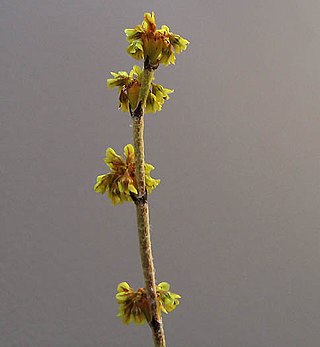
Eriogonum gracile is a species of wild buckwheat known by the common name slender woolly buckwheat.
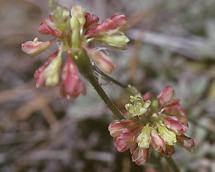
Eriogonum kelloggii is a rare species of wild buckwheat known by the common names Red Mountain buckwheat and Kellogg's buckwheat. It is endemic to Mendocino County, California, where it is known from only five occurrences on Red Mountain near Leggett. It grows in woodland habitat on serpentine soils.

Eriogonum siskiyouense is a rare species of wild buckwheat known by the common name Siskiyou buckwheat.

Eriogonum sphaerocephalum is a species of wild buckwheat known by the common names rock buckwheat and round-headed desert buckwheat. It is native to the western United States.

Eriogonum callistum is a rare species of wild buckwheat, known by the common name Tehachapi buckwheat.




















